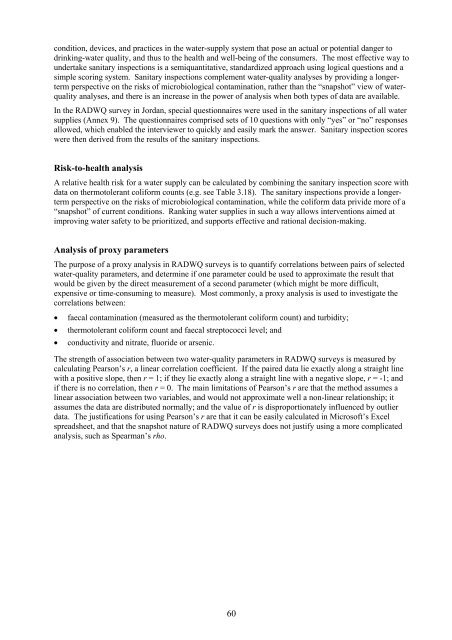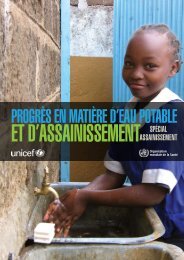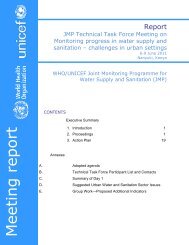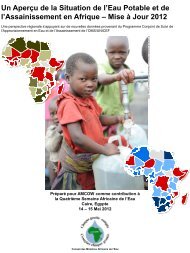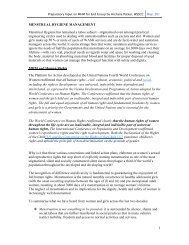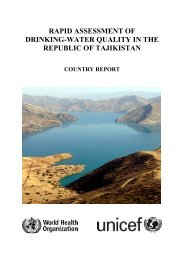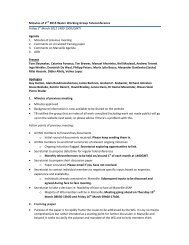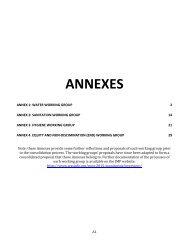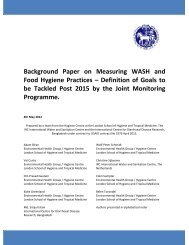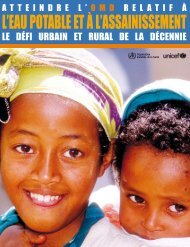Rapid assessment of drinking-water quality in the - WHO/UNICEF ...
Rapid assessment of drinking-water quality in the - WHO/UNICEF ...
Rapid assessment of drinking-water quality in the - WHO/UNICEF ...
Create successful ePaper yourself
Turn your PDF publications into a flip-book with our unique Google optimized e-Paper software.
condition, devices, and practices <strong>in</strong> <strong>the</strong> <strong>water</strong>-supply system that pose an actual or potential danger to<br />
<strong>dr<strong>in</strong>k<strong>in</strong>g</strong>-<strong>water</strong> <strong>quality</strong>, and thus to <strong>the</strong> health and well-be<strong>in</strong>g <strong>of</strong> <strong>the</strong> consumers. The most effective way to<br />
undertake sanitary <strong>in</strong>spections is a semiquantitative, standardized approach us<strong>in</strong>g logical questions and a<br />
simple scor<strong>in</strong>g system. Sanitary <strong>in</strong>spections complement <strong>water</strong>-<strong>quality</strong> analyses by provid<strong>in</strong>g a longerterm<br />
perspective on <strong>the</strong> risks <strong>of</strong> microbiological contam<strong>in</strong>ation, ra<strong>the</strong>r than <strong>the</strong> “snapshot” view <strong>of</strong> <strong>water</strong><strong>quality</strong><br />
analyses, and <strong>the</strong>re is an <strong>in</strong>crease <strong>in</strong> <strong>the</strong> power <strong>of</strong> analysis when both types <strong>of</strong> data are available.<br />
In <strong>the</strong> RADWQ survey <strong>in</strong> Jordan, special questionnaires were used <strong>in</strong> <strong>the</strong> sanitary <strong>in</strong>spections <strong>of</strong> all <strong>water</strong><br />
supplies (Annex 9). The questionnaires comprised sets <strong>of</strong> 10 questions with only “yes” or “no” responses<br />
allowed, which enabled <strong>the</strong> <strong>in</strong>terviewer to quickly and easily mark <strong>the</strong> answer. Sanitary <strong>in</strong>spection scores<br />
were <strong>the</strong>n derived from <strong>the</strong> results <strong>of</strong> <strong>the</strong> sanitary <strong>in</strong>spections.<br />
Risk-to-health analysis<br />
A relative health risk for a <strong>water</strong> supply can be calculated by comb<strong>in</strong><strong>in</strong>g <strong>the</strong> sanitary <strong>in</strong>spection score with<br />
data on <strong>the</strong>rmotolerant coliform counts (e.g. see Table 3.18). The sanitary <strong>in</strong>spections provide a longerterm<br />
perspective on <strong>the</strong> risks <strong>of</strong> microbiological contam<strong>in</strong>ation, while <strong>the</strong> coliform data privide more <strong>of</strong> a<br />
“snapshot” <strong>of</strong> current conditions. Rank<strong>in</strong>g <strong>water</strong> supplies <strong>in</strong> such a way allows <strong>in</strong>terventions aimed at<br />
improv<strong>in</strong>g <strong>water</strong> safety to be prioritized, and supports effective and rational decision-mak<strong>in</strong>g.<br />
Analysis <strong>of</strong> proxy parameters<br />
The purpose <strong>of</strong> a proxy analysis <strong>in</strong> RADWQ surveys is to quantify correlations between pairs <strong>of</strong> selected<br />
<strong>water</strong>-<strong>quality</strong> parameters, and determ<strong>in</strong>e if one parameter could be used to approximate <strong>the</strong> result that<br />
would be given by <strong>the</strong> direct measurement <strong>of</strong> a second parameter (which might be more difficult,<br />
expensive or time-consum<strong>in</strong>g to measure). Most commonly, a proxy analysis is used to <strong>in</strong>vestigate <strong>the</strong><br />
correlations between:<br />
<br />
<br />
<br />
faecal contam<strong>in</strong>ation (measured as <strong>the</strong> <strong>the</strong>rmotolerant coliform count) and turbidity;<br />
<strong>the</strong>rmotolerant coliform count and faecal streptococci level; and<br />
conductivity and nitrate, fluoride or arsenic.<br />
The strength <strong>of</strong> association between two <strong>water</strong>-<strong>quality</strong> parameters <strong>in</strong> RADWQ surveys is measured by<br />
calculat<strong>in</strong>g Pearson’s r, a l<strong>in</strong>ear correlation coefficient. If <strong>the</strong> paired data lie exactly along a straight l<strong>in</strong>e<br />
with a positive slope, <strong>the</strong>n r = 1; if <strong>the</strong>y lie exactly along a straight l<strong>in</strong>e with a negative slope, r = -1; and<br />
if <strong>the</strong>re is no correlation, <strong>the</strong>n r = 0. The ma<strong>in</strong> limitations <strong>of</strong> Pearson’s r are that <strong>the</strong> method assumes a<br />
l<strong>in</strong>ear association between two variables, and would not approximate well a non-l<strong>in</strong>ear relationship; it<br />
assumes <strong>the</strong> data are distributed normally; and <strong>the</strong> value <strong>of</strong> r is disproportionately <strong>in</strong>fluenced by outlier<br />
data. The justifications for us<strong>in</strong>g Pearson’s r are that it can be easily calculated <strong>in</strong> Micros<strong>of</strong>t’s Excel<br />
spreadsheet, and that <strong>the</strong> snapshot nature <strong>of</strong> RADWQ surveys does not justify us<strong>in</strong>g a more complicated<br />
analysis, such as Spearman’s rho.<br />
60


